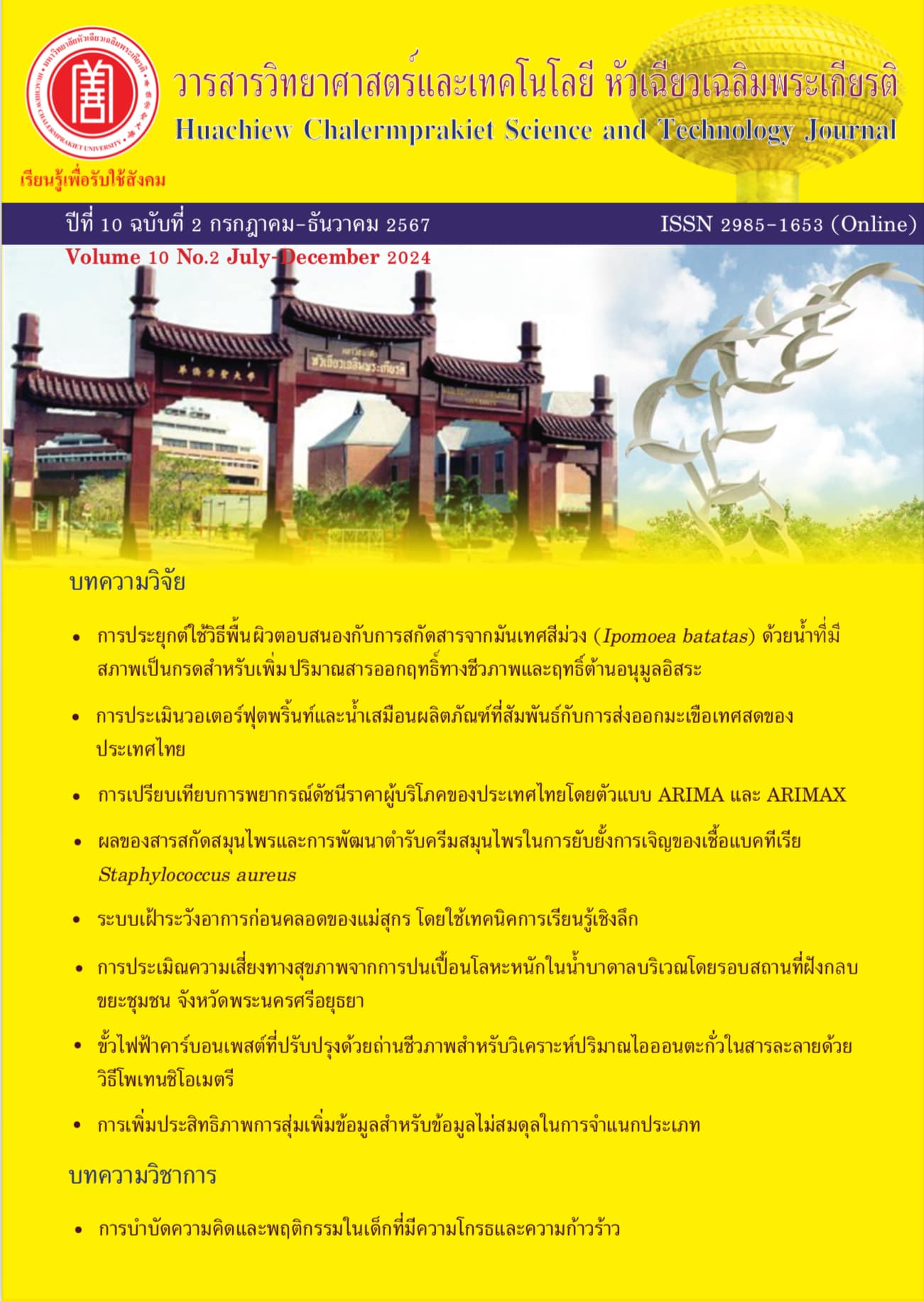การบำบัดความคิดและพฤติกรรมในเด็กที่มีความโกรธและความก้าวร้าว
คำสำคัญ:
การบำบัดความคิดและพฤติกรรม, ความโกรธ, ความก้าวร้าว, จิตเวชเด็กและวัยรุ่น, จิตบำบัดบทคัดย่อ
การบำบัดความคิดและพฤติกรรมเป็นจิตบำบัดประเภทหนึ่งที่นำมารักษาผู้ป่วยที่มีภาวะผิดปกติทางจิตได้อย่างมีประสิทธิภาพ ในปัจจุบันความโกรธและความก้าวร้าวในเด็กได้เพิ่มสูงขึ้นดังเห็นได้จากข่าวสารและสื่อสังคมต่าง ๆ บทความวิชาการนี้มีจุดประสงค์เพื่อทบทวนความรู้เกี่ยวกับการบำบัดความคิดและพฤติกรรมในเด็ก โดยมุ่งเน้นที่เด็กอายุ 8-16 ปี ที่มีความโกรธและความก้าวร้าวในฐานข้อมูลระดับชาติและนานาชาติ ในช่วงปี พ.ศ. 2541-2567 ผลการทบทวนพบว่า วิธีการบำบัดความคิดและพฤติกรรมในเด็กที่มีความโกรธและความก้าวร้าว ประกอบไปด้วย 3 วิธี ได้แก่ วิธีการเรียนรู้ด้านอารมณ์ วิธีการจัดการปัญหา และวิธีการพัฒนาทักษะ ซึ่งแต่ละวิธีมีเทคนิคย่อยเพื่อเสริมให้บรรลุผลสำเร็จ โดยบทความวิชาการนี้ผู้เขียนได้ใช้ประสบการณ์จริงจากการเป็นนักบำบัดร่วมกับผลจากการทบทวนความรู้ สรุป และบรรยายเนื้อหาทั้ง 3 วิธีดังกล่าวรวมถึงเทคนิคย่อย พร้อมยกตัวอย่างการนำไปใช้ในเด็กที่มีความโกรธและความก้าวร้าว ดังนั้นบทความนี้จึงเหมาะกับพยาบาล นักบำบัด บุคลากรทางการแพทย์ และผู้ที่สนใจทั่วไปที่ต้องการมีความรู้พื้นฐานเกี่ยวกับ CBT เพื่อใช้ในการบำบัดเด็กที่มีความโกรธและความก้าวร้าวต่อไป
เอกสารอ้างอิง
Slimi N, Shahanjarini AK, Shahkolai FR, Hamzeh B, Roshanaei G, Babamiri M. Aggression and its predictors among elementary students. J Inj Violence Res 2019;11(2):159-70.
American Psychiatric Association. Diagnostic and statistical manual of mental disorders. Diagnostic and Statistical Manual of Mental Disorders. 5th ed. Arlington: American Psychiatric Association; 2013.
Berkowitz L, Harmon-Jones E. Toward an Understanding of the Determinants of Anger. Emotion 2004;4(2):107-30.
Kassinove H, Sukhodolsky DG. Anger Disorders: Basic Science and Practice Issues. Issues Compr Pediatr Nurs 2009;18(3):173-205.
Potegal M, Davidson LP, Davidson RJ. Temper Tantrums in Young Children: 1. Behavioral Composition. J Dev Behav Pediatr 2003;14:140-7.
Potegal M, Kosorok MR, Davidson RJ. Temper Tantrums in Young Children: 2. Tantrum Duration and Temporal Organization. J Dev Behav Pediatr 2003;24(3):148-54.
Blanchard-Fields F, Coats AH. The experience of anger and sadness in everyday problems impacts age differences in emotion regulation. Dev Psychol 2008;44(6):1547-56.
Chereji SV, Pintea S, David D. The relationship of anger and cognitive distortions with violence in violent offenders’ population: a meta-analytic review. Eur J Psychol Appl Legal Context 2012;4(1):59-77.
Connor DF. Aggression and antisocial behavior in children and adolescents: research and treatment. New York: Guilford Press; 2012.
Tremblay RE. Understanding development and prevention of chronic physical aggression: towards experimental epigenetic studies. Philos Trans R Soc Lond B Biol Sci 2008;363(1503):2613-22.
Allen JJ, Anderson CA. Aggression and Violence: Definitions and Distinctions. The Wiley Handbook of Violence and Aggression. 1st ed. Oxford: John Wiley & Son; 2017.
Loeber R, Green SM, Lahey BB, Kalb L. Physical fighting in childhood as a risk factor for later mental health problems. Am Acad Child Adolesc Psychiatry 2000;39(4):421-8.
ณัชชา ศรีมหาพรหม, สมศักดิ์ จีวัฒนา, กระพัน ศรีงาน. ปัจจัยที่มีผลต่อพฤติกรรมก้าวร้าวของนักเรียนชั้นมัธยมศึกษาปีที่ 3. วารสารมนุษย์ศาสตร์และสังคมศาสตร์ 2566;42(1):85-95.
ณัทธร พิทยรัตน์เสถียร. โมโม่โมโหแล้ว. พิมพ์ครั้งที่ 3. กรุงเทพฯ: สำนักพิมพ์คิดเทอเรซี่; 2561.
Sukhodolsky DG, Scahill L. Cognitive-behavioral therapy for anger and aggression in children. New York: Guilford Press; 2012.
Lee AH, DiGiuseppe R. Anger and aggression treatments: a review of meta-analyses. Current Opinion in Psychology. Curr Opin Psychol 2018;19:65-74.
King R. Cognitive therapy of depression. Aaon Beck, John Rush, Brian Shaw, Gary Emery. New York: Guilford, 1979 Aust N Z J psychiatry 2002;36(2):272-5.
ธนกฤต ลิขิตธรากุล, ภาสกร คุ้มศิริ. จิตบำบัดความคิดและพฤติกรรมกับการติดเกม. วารสารจิตวิทยาคลินิกไทย 2565;53(1):71-84.
ฐิตินันท์ อ้วนล่ำ, นรุตน์ แพงพรมมา. การพยาบาลเด็กออทิสติกที่มีพฤติกรรมก้าวร้าว. วารสารโรงพยาบาลมหาสารคาม 2563;17(2):68-76.
Borenstein M, Hedges LV, Higgins JP, Rothstein HR. Introduction to meta-analysis. 2nd ed. Hoboken: John Wiley & Sons; 2021.
Del Vecchio T, O’Leary KD, Effective of anger treatments for specific anger problems: a meta-analytic review. Clin Psychol Rev 2004;24(1):15-34.
Beck JS. Cognitive behavior therapy: Basics and beyond. 3rd ed. New York: The Guilford Press; 2020.
Nunez K. ABC model of cognitive behavioral therapy: how it works. Healthline [Internet]. 2020. [citd 2024 April 10]. Available from: https://www.healthline.com/health/abc-model
Lee AH, DiGiuseppe R. Anger and aggression treatments: a review of meta-analyses. Curr Opin Psychol 2018;19(1):65-74.
Ho BPV, Carter M, Stephenson J. Anger management using a cognitive-behavioural approach for children with special education needs: a literature review and meta-analysis. J Disabil Dev Educ 2010;57(3):245-65.
Candelaria AM, Fedewa AL, Ahn S. The effects of anger management on children’s social and emotional outcomes: A meta-analysis. Sch Psychol Int 2012;33(6):596-614.
Sukhodolsky DG, Kassinove H, Gorman BS. Cognitive-behavioral therapy for anger in children and adolescents: a meta-analysis. Aggress Violent Behav 2004;9(3):247-69.
Beck R, Fernandez E. Cognitive-behavioral therapy in the treatment of anger: A meta-analysis. Cogn Ther Res 1998;22(1):63-74.
Fossum S, Handegård BH, Adolfsen F, Vis SA, Wynn R. A meta-Analysis of long-term outpatient treatment effects for children and adolescents with conduct problems. J Child Fam Stud 2015;25(1):15-29.
ณัทธร พิทยรัตน์เสถียร. Basic Skill in CBT. พิมพ์ครั้งที่ 1. กรุงเทพฯ: สำนักพิมพ์จุฬาลงกรณ์มหาวิทยาลัย; 2565.
Kennerley H, Kirk J, Westbrook D. Introduction to Cognitive Behaviour Therapy: Skills & Applications. 3rd ed. London: Sage Publications; 2017.
Spence SH. Social skills training with children and young people: theory, evidence and practice. Child Adolesc Ment Health 2003;8(2):50-104.
ดาวน์โหลด
เผยแพร่แล้ว
รูปแบบการอ้างอิง
ฉบับ
ประเภทบทความ
สัญญาอนุญาต
ลิขสิทธิ์ (c) 2024 วารสารวิทยาศาสตร์และเทคโนโลยี หัวเฉียวเฉลิมพระเกียรติ

อนุญาตภายใต้เงื่อนไข Creative Commons Attribution-NonCommercial-NoDerivatives 4.0 International License.
บทความทุกบทความที่ได้รับการตีพิมพ์ถือเป็นลิขสิทธิ์ของ คณะวิทยาศาสตร์และเทคโนโลยี มหาวิทยาลัยหัวเฉียวเฉลิมพระเกียรติ



